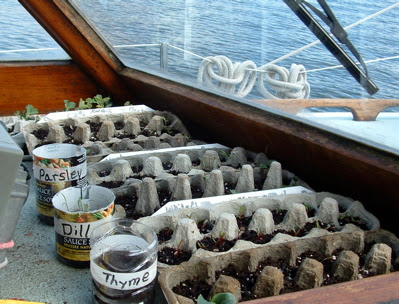Another way we try to practice food justice is by seeking out Fair Trade products, where the grower receives a living wage and environmentally friendly methods are used in production. And we try to find sources of just meat – where the animal has a good life!
A great way to move towards eating locally is to grow it yourself – or trade with someone who does.
Gardening and living on a boat don’t go together easily. That’s why this summer at Crippen Cove was such a delight. We started our garden last summer by building a raised garden bed. We collected planks on beaches and towed them to Crippen. Thomas and nephew Matthew constructed the bed on a patch of removed sod, then we layered the upside down sod, large rocks, beach gravel, sand and then soil removed from the sod. We dug more soil from what had been gardens years ago and covered it all with a large layer of seaweed.

We spent the winter planning our seeds and headed north with what we’d found. Here is the La Sonrisa greenhouse, it felt great to be surrounded with little green children:
When we got to Crippen Cove the garden bed was perfect. We tucked the little egg carton nests into the soil and planted more seeds. And watched things grow!
Garden stir fry
On La Sonrisa we gather food wherever we go – it is our way of being part of the neighbourhood. The basic activity of getting food from our surroundings we have in common with all our coastal neighbours.Our diet is based on what we find around us, and we eat whatever we gather.
Just before heading south we harvested the garden


And brought our harvest aboard

 Now we just have to figure out how to grow winter gardens at our families' places down south.
Now we just have to figure out how to grow winter gardens at our families' places down south.On a sad note, as we were leaving Prince Rupert we spoke to a seasoned gill net fisher preparing to head home.
"How was the fishing?"
“Good year for the pink salmon. In all my years fishing, I’ve never seen ‘em that plentiful.”
"That's wonderful!" we said. Last year was a very poor year for pinks.
“But we can’t sell them. Price went from .15/lb to nothing. Same as we were getting 20 years ago and look at the price of gas!"
Wild Pink salmon are the most affordable and sustainable source of protein that coastal people can eat. Our natural, local food is overflowing the fishing nets. And yet pink salmon aren't in our diets. The "market" deems them worthless. Somehow we 100 Km Diet people have to turn this around!


















1 comment:
Wonderful pics! Who wouldn't want to eat locally when they see that delicious looking stuff?
We had our first 'mostly from the garden' meal this weekend: Peter's potatoes, fran's purple turnips and slender green beans...unfortunately the pig wasn't homegrown!We're looking forward to having a much bigger garden next year on our own land, and beginning to seek out 100 km sources of other things we need.
We still miss you both and times on La Sonrisa II - thanks for including us in the pictures!
Post a Comment